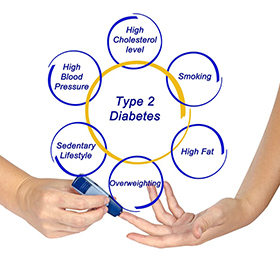
Diabetes type 2 is just a symptom of a diseased lifestyle. It is probably our body’s mechanism to store food in times of food shortages (which we needed as hunter-gatherers when food shortage was a frequent occurrence). Now we have too much of the wrong food all of the time. The signs and symptoms of diabetes, including thirst and fatigue, are just messages to tell us to change. If we don’t change then we develop insulin resistance, which tells us that we already have too much food (energy) stored in the cell and to stop sending in the sugar. By this time we may have spent 10 or 20 years not listening to the body’s messages. Under normal conditions, our cells take the sugar out of the blood to provide us with the energy our cells need to function. If the sugar remains in the bloodstream, it causes damage to the blood and to cells in the blood. But when there is too much energy stored in the cells, the cells stop taking the sugar in, because we just can’t use any more. Blood sugar levels are also one of the best predictors of dementia later in life.
Although inflammation, oxidation and acidosis (IOA) are natural and essential for a healthy body, they can be seriously problematic if they become chronic and reoccurring as a result of our body being out of balance. Recent studies have established that the three conditions combined are a leading pathogenic force in the development of chronic diseases—including diabetes, cancers, cardiovascular disease, autoimmune diseases (including asthma and arthritis), osteoporosis, multiple sclerosis, dementia and even depression, obesity and premature ageing.
In modern medicine, we treat the condition that occurs down the line, such as diabetes, by giving the person blood-sugar-lowering drugs. This lowers the blood sugar but does not treat the condition that is causing the diabetic problem. The problem is not high levels of sugar in the blood; it is the damage that has been done, often over decades, by poor diet and lifestyle that have led to chronic inflammation, oxidation and acidosis, the combination of which eventually results in high blood sugar. High blood sugar is just the symptom; the damage is in the cells—in our powerhouse called the mitochondria—and is the result of inflammation, oxidation and acidosis.